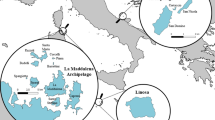Abstract
Size assortative mating is a common invertebrate mating pattern and is usually accompanied by male and female sexual selection, and these three behaviours can contribute to reproductive isolation. Two distinct populations of the marine prosobranch Littorina saxatilis, H and M, occur within 15 m of each other on the same shore. Previous studies have demonstrated that these two forms have different reproductive strategies and that the rare hybrids between the two forms show evidence of reproductive dysfunction and hence are less fit than the assumed parental forms. In both populations, female shell height was shown to be a predictor of the number of embryos contained within the brood pouch. The mean shell height of the M population was significantly larger than that of the H population, and the M population matures at a larger shell size than the H population. The two populations show complete assortative mating to type in the field, and occupy different microhabitats on the same shore. Therefore, laboratory-based experiments were performed to determine if assortative mating was maintained in sympatry and also to determine the effect of population density on mate choice. The males of both populations showed sexual selection for female size, choosing to mate with females approximately 10% larger than themselves from an assortment of female sizes. The M population showed complete assortative mating to type, irrespective of the density of H and M females, whereas at low densities the H males did occasionally mate with M females. The role of assortative mating and reinforcement (due to natural selection acting against the less fit hybrids), in maintaining the partial reproductive barrier between the two populations is discussed.
Similar content being viewed by others
References
Arnqvist, G., L. Rowe, J. J. Krupa & A. Sih, 1996. Assortative mating by size: a meta-analysis of mating patterns in water-striders. Evol. Ecol. 10: 265–284.
Barton, N. H. & G.M. Hewitt, 1985. Analysis of hybrid zones. Ann. Rev. Ecol. Syst. 15: 133–164.
Butlin, R., 1987. Speciation by re-inforcement. TREE 2: 8–13.
Butlin, R., 1989. Reinforcement of Premating Isolation. In D. Otte & J. A. Endler (eds), Speciation and its Consequences. Sinauer, Sunderland, Mass., U.S.A.: 158–179.
Crespi, B. J., 1989. Causes of assortative mating in arthropods. Anim. Behav. 38: 980–1000.
Diehl, S. R. & G. L. Bush, 1989. The Role of Habitat Preference in Adaptation and Speciation. In D. Otte & J. A. Endler (eds), Speciation and its Consequences. Sinauer, Sunderland, Mass., U.S.A.: 345–365.
Erlandsson, J. & K. Johannesson, 1994. Sexual selection on female size in a marine snail, Littorina littorea (L.). J. exp. mar. Biol. Ecol. 181: 145–157.
Erlandsson, J. & V. Kostylev, 1995. Trail following, speed and fractal dimension of movement in a marine prosobranch, Littorina littorea, during a mating and a non-mating season. Mar. Biol. 122: 87–94.
Gilbert, D. G. & W. T. Starmer, 1985. Statistics of sexual isolation. Evolution 39: 1380–1383.
Grahame, J., S. L. Hull, P. J. Mill & R. Hemmingway, 1997. Discovering unrecognised diversity among marine molluscs. In Ormond, R. F. G., J. D. Gage & M. V. Angel (eds), Marine Biodiversity: Patterns and Processes. Cambridge University Press: 293–318.
Hull, S. L., 1994. Polymorphism, physiological ecology and the systematics of Littorina. Unpublished Ph.D. thesis, University of Leeds.
Hull, S. L., J. Grahame & P. J. Mill, 1996. Morphological divergence and evidence for reproductive isolation in Littorina saxatilis (Olivi) in northeast England. J. moll. Stud. 62: 89–99.
Janson, K., 1983. Selection and migration in two distinct phenotypes of Littorina saxatilis in Sweden. Oecologia 59: 58–61.
Janson, K., 1985. Variation in the occurrence of abnormal embryos in the females of the intertidal gastropod Littorina saxatilis Olivi. J. moll. Stud. 51: 64–68.
Janson, K. & P. Sundberg, 1983. Multivariate morphometric analysis of two varieties of Littorina saxatilis from the Swedish west coast. Mar. Biol. 74: 49–53.
Johannesson, K., B. Johannesson & E. Rolan-Alvarez, 1993. Morphological differentiation and genetic cohesiveness over a microenvironmental gradient in the marine snail Littorina saxatilis. Evolution 47: 1770–1787.
Johannesson, K., E. Rolan-Alvarez & A. Ekendahl, 1995. Incipient reproductive isolation between two sympatric morphs of the intertidal snail Littorina saxatilis (Olivi). Evolution 49: 1180–1190.
Palumbi, S. R., 1994. Genetic divergence, reproductive isolation and marine speciation. Ann. Rev. Ecol. Syst. 25: 547–572.
Raffaelli, D. G., 1977. Observations on the copulatory behaviour of Littorina rudis (Maton) and Littorina nigrolineata (Gray). Veliger 20: 75–77.
Ribi, G. & A. H. Porter, 1996. Mating between two hybridising species, Viviparous ater and V. contectus (Mollusca: Prosobranchia). Anim. Behav. 49: 1389–1398.
Ridley, M., 1993. Evolution. Blackwell Scientific Publications, New York, 670 pp.
Roberts, D. J. & R. N. Hughes, 1981. Growth and reproductive rates of Littorina rudis from three contrasted shores in North Wales, U.K. Mar. Biol. 58: 47–54.
Rolan-Alvarez, E., K. Johannesson & A. Ekendahl, 1995. Frequency and density-dependent selection in natural populations of Littorina saxatilis (Olivi). Hydrobiologia 309: 167–172.
Rolan-Alvarez, E., E. Rolan & K. Johannesson, 1996. Differentiation in radular and embryonic characters, and further comhyments on gene flow, between two sympatric morphs of Littorina saxatilis (Olivi). Ophelia 45: 1–15.
Ross, B. & A. J. Berry, 1991. Annual and lunar reproductive cycles in Littorina saxatilis (Olivi) and differences between breeding in the marine Firth of Forth and the Forth Estuary. J. moll. Stud. 57: 347–358.
Saur, M., 1990. Mate discrimination in Littorina littorea (L.) and Littorina saxatilis (Olivi) (Mollusca: Prosobranchia). Hydrobiologia 193: 261–270.
Warwick, T., 1982. A method of maintaining and breeding members of the Littorina saxatilis (Olivi) species complex. J. moll. Stud. 48: 368–370.
Rights and permissions
About this article
Cite this article
Hull, S.L. Assortative mating between two distinct micro-allopatric populations of Littorina saxatilis (Olivi) on the northeast coast of England. Hydrobiologia 378, 79–88 (1998). https://doi.org/10.1023/A:1003237521419
Issue Date:
DOI: https://doi.org/10.1023/A:1003237521419




